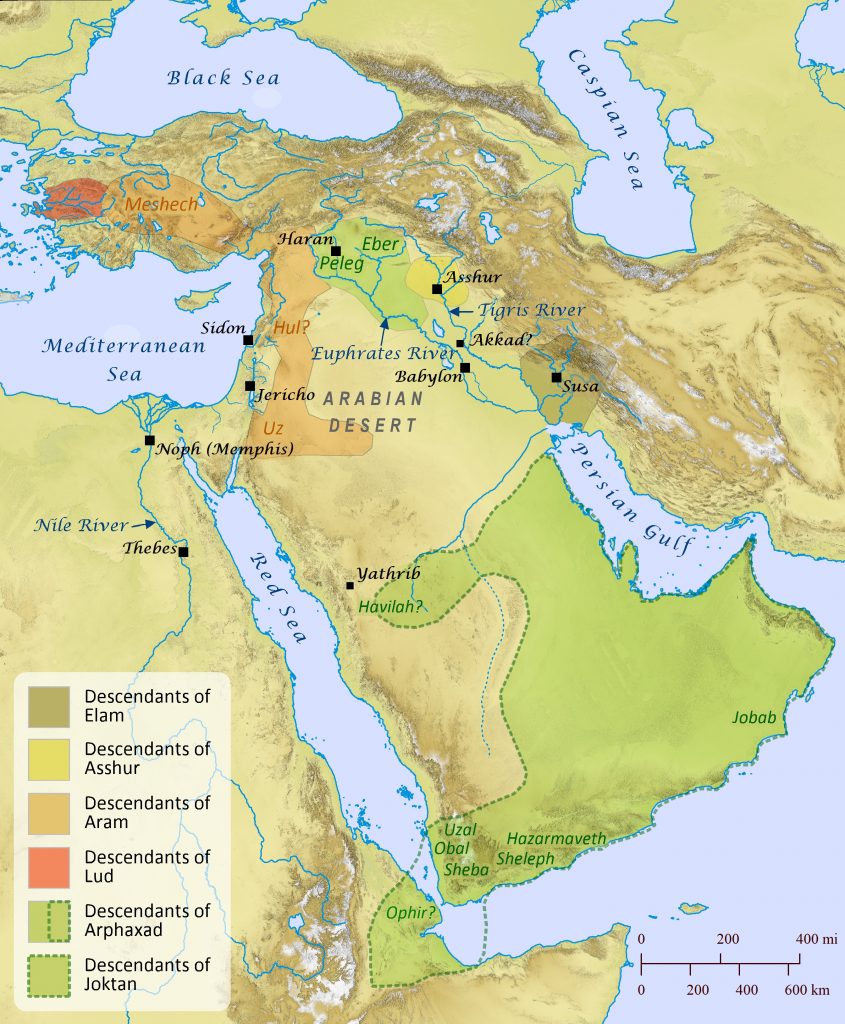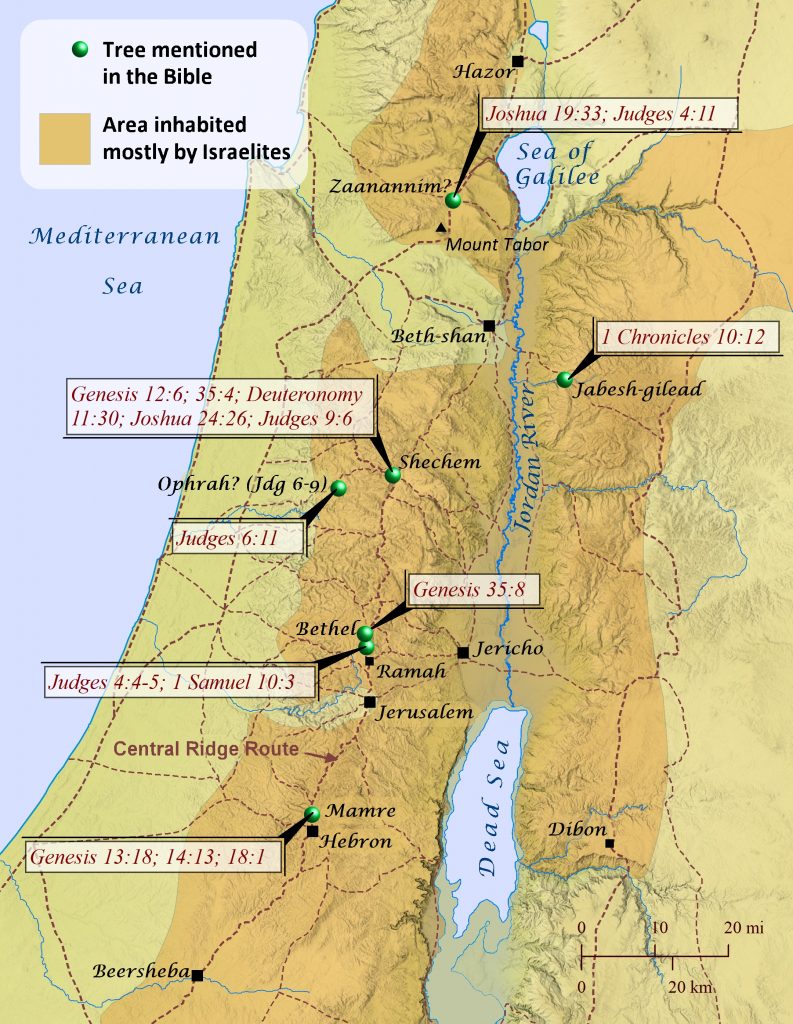Genesis 10
The descendants of Noah’s son Japheth are listed in what is commonly called the Table of Nations, the Israelites’ oldest catalog of the peoples of the ancient Near East. While it is difficult to identify with certainty where many of these peoples lived, generally they are believed to have been located as shown here. Japheth’s sons Gomer and Javan gave rise to other people groups cited in the list, so they have been shown as broad regions on the map rather than as specific people groups. Japheth’s sons Magog, Madai, Tubal, Meshek, and Tiras are displayed this way as well, though no specific peoples are listed as descending from them.

Table of Nations: Shem’s Descendants
Genesis 10
The descendants of Noah’s son Shem are listed in what is commonly called the Table of Nations, the Israelites’ oldest catalog of the peoples of the ancient Near East. While it is difficult to identify with certainty where many of these peoples lived, generally they are believed to have been located as shown here. Shem’s sons Elam, Arphaxad, and Aram each gave rise to other people groups cited in the list, so they have been shown as broad regions on the map rather than as specific people groups. Shems’s sons Asshur and Lud are displayed this way as well, though no specific peoples are listed as descending from them. The Israelites were descended from Arphaxad through Shelah, Eber (thus, the Hebrews), and Peleg. In Luke’s account of Jesus’ genealogy an ancestor named Cainan is inserted between Arphaxad and Shelah as well (Luke 3:35-36), suggesting that genealogies are sometimes abbreviated in the Bible, and the term son can convey the broader meaning of “descended from.” It is interesting to note that Peleg’s descendants are not further detailed while those of his brother Joktan is extensively delineated. Perhaps this is because the Israelites’ immediate ancestors would have already been very familiar to the readers, who were Israelites, so this did not require further explanation. It is also interesting to note a few areas of overlap between Shem’s descendants and the descendants of Ham and Japheth, such as Havilah, Sheba, and Meshech. Meshech in verse 23 reads Mash in Hebrew, but Meshech is the reading of the Septuagint and the parallel passage in 1 Chronicles 1:17, and it makes geographic sense by physically connecting Lud with the rest of the Shemite (also called Semite) peoples.

Table of Nations: Ham’s Descendants
Genesis 10
The descendants of Noah’s son Ham are listed in what is commonly called the Table of Nations, the Israelites’ oldest catalog of the peoples of the ancient Near East. While it is difficult to identify with certainty where many of these peoples lived, generally they are believed to have been located as shown here. Ham’s sons Cush, Egypt, and Canaan each gave rise to other people groups cited in the list, so they have been shown as broad regions on the map rather than as specific people groups. Ham’s son Put is displayed this way as well, though no specific peoples are listed as descending from him. By viewing the sons as regions, one thing that becomes clear is that for the Israelites the term Cushites referred to more than just the people living directly south of Egypt. It also included those along the entire eastern coast of the Red Sea (see also Numbers 12:1; 2 Chronicles 14:8-14) and even the area surrounding Babylon.

Places Referenced by Trees in the Bible
When modern readers encounter a verse in Scripture that references a “great tree” to locate where an event took place, there is a good chance they will dismiss it as somewhat irrelevant to the significance of the passage. But for the original audience of Scripture, these tangible references provided a very real connection to the event and allowed people to readily visualize what took place, because many of these people were probably already familiar with the great tree referenced or could possibly go see it for themselves. There are at least a dozen references to seven different great trees in Scripture (Genesis 12:6; 13:18; 14:13; 18:1; 35:4-8; 1 Samuel 10:3; Deuteronomy 11:30; Joshua 24:26; Judges 4:4-11; 6:11; 9:6; 1 Chronicles 10:12), and these references span from the time of Abraham to the time of Saul. There were no doubt other great trees that existed that were simply never mentioned in the Bible. The trees noted in Scripture were typically oaks or terebinths, although even palm trees could become noteworthy landmarks. For example, the judge Deborah held court under a palm tree between Bethel and Ramah (Judges 4:4-5). Besides simply being points of reference, these trees sometimes took on ceremonial significance as well, either religiously or politically. When the citizens of Shechem gathered to crown Abimelek king during the time of the Judges, they did so beside the great tree at the pillar in Shechem (Judges 9:6). The prophet Hosea later condemned Israel for offering pagan sacrifices under “oak, poplar, and terebinth, where the shade is pleasant” (Hosea 4:13). No doubt many of these pagan sacrifices were performed under great trees that served as recognized places for making offerings. It is not surprising, then, that most of the locations associated with great trees in the Bible lay along main routes in Israel, especially the Central Ridge Route, which ran from Shechem to Beersheba. On a more personal note, while my wife and I were teaching at a Bible college in rural Kenya we witnessed a similar method of place referencing by means of a great tree. Our campus was dominated by a massive, 500-year old mumbu tree (typically called a baobab tree by Westerners), and, as a result, the town nearby was named Mumbuni (“place of the mumbu”). The college president, who was Kenyan, told us that before the coming of Christianity to the area, the tree had been a place where locals offered animal sacrifices to spirits.

Deborah and Barak Defeat Sisera
Judges 4-5
The story of the victory of Deborah and Barak over Jabin and Sisera is well known, and the location of the battle is clear. Less clear, however, are the locations of other places mentioned in the story, but the context of the story and Joshua’s descriptions of Israel’s tribal boundaries (Joshua 19) enable some possible identifications to be made. The story takes place in the time of the Judges, and a judge named Deborah was holding court in the territory of Benjamin. Meanwhile a man named Jabin was ruling over the Canaanites in the north, and his capital was located at Hazor, which must have been reinhabited after the Israelites had completely destroyed it during the conquest of Canaan (Joshua 11). Jabin’s commander Sisera was located in Harosheth-haggoyim (possibly meaning “farmland of the Gentiles”), a location that is not certain, but the context of the story suggests it refers to the plain near Megiddo and the Kishon River. Deborah called upon a man named Barak to lead an army of Israelites up Mount Tabor to draw Sisera to attack with his forces. Barak was from Kedesh-naphtali, a town that is noted as being close to Zaanannim. At some point a Kenite named Heber and his wife Jael had also set up their camp at the Oak at Zaanannim, which must have been located a little west of Jabneel (Joshua 19:33). The location of Jabneel is well established, leading some scholars locate Zaanannim a little further west near modern ash-Shagara, which is also called Ilanya and likely preserves the word Elon (“oak”). Regarding Kedesh-naphtali, this author has recently discovered that Khirbet Kashtah would make a good candidate (shown on this map), since it satisfies the requirements of Joshua 19:33 and Judges 4 very well. Ash-Shagara and Khirbet Kashtah are both appropriately located within territory that belonged to Naphtali, and they sit along two key routes just north of Mount Tabor, where Israel’s troops were gathered. So it is fitting that Sisera would have passed by these locations as he fled the battle on foot, perhaps on his way to King Jabin in Hazor. Finally, it is not difficult to see how the name Kedesh could have evolved into Kashtah over time. Returning to the story, we read that Sisera and his vast army of chariots advanced to Mount Tabor, and the Israelites charged quickly down the mountain to counter-attack. The Israelites routed the Canaanites and pursued them all the way back to Harosheth-haggoyim. Deborah’s song commemorating the victory suggests that a sudden downpour also swelled the Kishon River, causing the chariots to become stuck in the mud (Judges 5:4-21). The story concludes by recounting how Sisera himself met his demise at the hands of Jael while he was fleeing on foot. After this, Jabin’s strength was broken, and the Israelites continued to press against him until he was destroyed.

